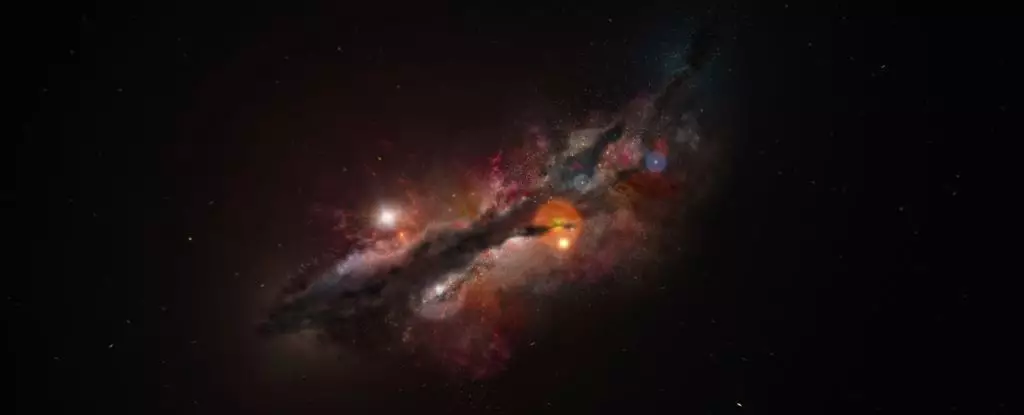Scientists have recently unveiled a stunning discovery that challenges our fundamental understanding of galaxy formation. The newly observed galaxy, JADES-GS-z14-0, has been found to be teeming with oxygen a mere 300 million years post-Big Bang—an unanticipated twist that flips conventional wisdom on its head. Prior to this finding, it was widely accepted that heavier elements beyond hydrogen and helium would not significantly emerge so early in cosmic history. This revelation hints at a rapidly maturing Universe that might be far more complex than previously imagined.
Cosmologist Sander Schouws from Leiden Observatory accurately summarizes the implications of this finding, likening it to encountering an adolescent when we’d only expect to see infants. His assertion implies that galaxies such as JADES-GS-z14-0 have undergone illumination-altering evolution at a pace that goes against established beliefs about cosmic timelines. This discovery not only surprises researchers but also adds weight to the large body of evidence suggesting that galaxies formed and matured much faster than we could ever have expected in the early Universe.
The Growth of Galaxies: A Cosmic Enigma
The very existence of JADES-GS-z14-0 raises troubling questions for current cosmological models. To be observable across a staggering distance of over 13.4 billion light-years, JADES-GS-z14-0 must possess considerable luminosity and size. Existing theories struggle to reconcile the galaxy’s immense presence with the comparatively brief period since the Big Bang. This anomaly calls into question the durations required for primary elements like hydrogen and helium to coalesce into massive galaxies.
Initially, following the Big Bang, the Universe was a pristine sea of hydrogen and helium. Over time, through gravitational collapse, the gas formed the first stars. These stellar giants began to fuse lighter elements into heavier ones, creating oxygen—a process culminating only with the death of those stars in cataclysmic supernovae. This sequence of events suggests that the formation of oxygen should take significantly longer than what we are now observing in JADES-GS-z14-0.
Yet, when astronomers, using the Atacama Large Millimeter/submillimeter Array in Chile, measured this galaxy, they detected oxygen levels that exceeded predictions by a staggering factor of ten. The data beguile scientists and reshape their understanding of elemental production in the Universe at such an early stage. As astrophysicist Stefano Carniani from the Scuola Normale Superiore points out, the implications of discovering a mature galaxy during the Universe’s infancy compel a reevaluation of when and how galaxies formed.
Decoding Cosmic Evolution: The Role of Advanced Technology
The evolution of our understanding of the cosmos has been substantially bolstered by technological advancements, particularly with the launch of the James Webb Space Telescope (JWST). Equipped with unparalleled infrared sensitivity, it specializes in detecting redshifted light from remote galaxies. Since its deployment, JWST has revolutionized the field, revealing the existence of more mature galaxies at earlier cosmic epochs than previously anticipated.
This ongoing journey to peel back the layers of the Universe is analogous to a detective unraveling a grand, complex mystery. Each new discovery serves as a clue, helping to build a more coherent narrative of cosmic history. The recent detection of oxygen in JADES-GS-z14-0 adds an essential piece to this mosaic, suggesting that galaxies may not only have formed more quickly but also evolved in ways we have yet to fully grasp. The nuances fueling this ongoing cosmic investigation invite scientists to contemplate the implications for the broader timeline of the Universe itself.
Challenging Established Narratives
The urgency to redefining established narratives is palpable as the implications of discoveries such as JADES-GS-z14-0 challenge the status quo. Current models of cosmological chronology hinge upon well-validated timeframes based upon previous observations and theoretical expectations. Yet here we stand, witnessing a paradigm shift that necessitates the reevaluation of age-old assumptions. The findings fuel discourse among astronomers urging the scientific community to scrutinize the very foundations upon which current cosmological models rest.
The discovery not only enriches our appreciation for the early moments post-Big Bang but also stirs curiosity concerning what this rapid evolution meant for subsequent galactic development. How might this influence the formation of clusters, superclusters, and even larger cosmic structures? Each question leads to further investigations, potentially unraveling cosmic mysteries that have puzzled astronomers for decades.
In theorizations and ongoing conversations in academic literature—two recent papers have been accepted into prestigious journals like The Astrophysical Journal and Astronomy & Astrophysics—astrophysicists have begun plotting the trajectory of this research, hoping to illuminate the early Universe and explain how these unexpected patterns of formation interweave into our understanding of the cosmos.

